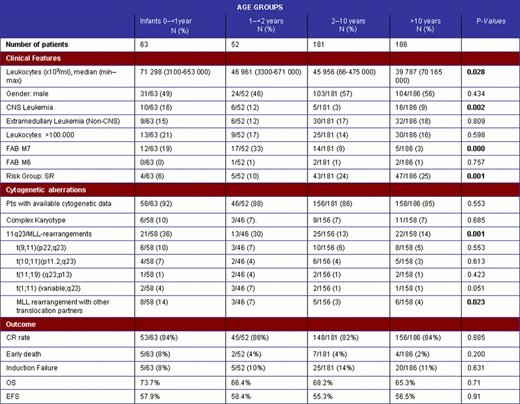Abstract
Abstract  3585
3585
The prognosis of paediatric patients (pts) with Acute Myeloid Leukemia (AML) has significantly improved over time not only in standard risk (SR) but also in high risk (HR) children. Pts < 1 year of age (infants) affected by AML are generally considered to be at HR. This is due to the prevalence of prognostically unfavourable clinical and cytogenetic/molecular features and to a greater vulnerability to treatment toxicities. We analyzed clinical and biological characteristics, as well as outcome of infants treated with the AIEOP AML 2002/01 protocol, comparing them to those of older children.
Between 12/2002 and 06/2011, 63 infants with AML other than promyelocytic leukaemia were treated with the AIEOP AML 2002/01 protocol. Children with Down syndrome were excluded. Clinical and biological features compared to the ones of 3 different age groups (1–<2 years; 2–10 years; >10 years) are reported in Table 1. Treatment was administered according to the following risk-based stratification: pts with isolated CBF-b+ leukemia achieving complete remission (CR) after the first induction course were considered to be at Standard Risk (SR), whereas all the others were assigned to the HR group. The treatment schedule administered to infants was: 2 courses of 7-day induction therapy (idarubicin, cytarabine and etoposide: ICE 3+5+7) and 2 consolidation courses based on high-dose cytarabine (HD-Ara-c), combined with either etoposide during the first course (AVE 3+4) or mitoxantrone during the second course (HAM 3+2). After consolidation, infants were eligible to allogeneic (ALLO) HSCT in first CR from a HLA-identical relative, if available, or from alternative donors, namely unrelated donors or HLA-mismatched relatives. CR rate, early death (ED), induction failure (IF), overall survival (OS) and event free survival (EFS) of infants were calculated and compared to those of other age groups.
Compared to pts of other age groups, infants had significantly more CNS involvement at diagnosis (P=0.002), were assigned to the FAB M7 subtype (P=0.000) and to the HR risk group (P=0.001) (Table 1). The median white blood cell (WBC) count at diagnosis was higher in infants (P=0.028), being 71,298×103/ml (range 3,100–653,000). Comparing pts with available cytogenetic data in the different age groups, infants showed a significantly higher incidence of 11q23/MLL-rearrangements (P=0.001). The incidence by partners of 11q23/MLL-rearrangements were 10%, 7%, 1%, 4% and 14% for t(9;11), t(10;11), t(11;19), t(1;11) and other translocation partners, respectively. Infants had CR, ED and IF rates of 84%, 8% and 8%, respectively, with no statistically significant differences with other age groups. Forty-five out of 63 infants (71%) received an ALLO HSCT in first CR. With a median follow up time of 57 months (range 3–130) the 8-year probability of OS and EFS of infants were 74% and 58%, respectively, with no significant differences compared with the other age groups.
Infants < 1 year of age at diagnosis enrolled in the AIEOP AML 2002/01 protocol presented with a significantly higher incidence of prognostically unfavourable features, like high WBC count, FAB M7 subtype, 11q23/MLL-rearrangements and CNS involvement. Despite this, a treatment strategy including a wide use of ALLO HSCT in first CR for these pts resulted in a final outcome which was not statistically different from that observed in the other age groups. Our results compare favourably with previously published data on infants with AML.
No relevant conflicts of interest to declare.
Author notes
Asterisk with author names denotes non-ASH members.

This icon denotes a clinically relevant abstract


